Dual Monitor Wallpaper Modern Art Mass Effect Art Alliance Fleet Tokyo

Known for their militaristic and disciplined culture, the turians were the third race to join the Citadel Council. They gained their Quango seat afterwards defeating the hostile krogan for the Council during the Krogan Rebellions. The turians deployed a salarian-created biological weapon called the genophage, which virtually sterilised the krogan and sent them into a decline. The turians then filled the peacekeeping niche left past the once-cooperative krogan, and eventually gained a Quango seat in recognition of their efforts.
Originally from the planet Palaven, turians are best known for their military role, peculiarly their contributions of soldiers and starships to the Citadel Fleet. They are respected for their public service ethic—it was the turians who get-go proposed creating C-Sec—but are sometimes seen as imperialist or rigid past other races. There is some antagonism between turians and humans, largely due to the turian role in the First Contact War. This bitterness is slowly beginning to heal—equally shown by the cooperation of the ii races on the construction of the SSV Normandy—but many turians still resent humans, and vice versa.
Contents
- i Biological science
- 2 History
- ii.1 The Unification State of war
- ii.2 The Krogan Rebellions
- 2.3 Relay 314 Incident
- 2.4 The Reaper War
- three Culture
- three.1 Economy
- 3.2 Faith
- 4 Government
- 5 Armed services
- 5.one Known Military Actions
- half-dozen Notable Turians
- vii Turian Worlds
- 8 Trivia
- 9 See Besides
- 10 References
Biological science

Turians typically stand over 6 anxiety alpine [one.8m], have ii long, proportionately thick fingers and an opposable pollex on each hand, each tipped with talons, and a set of mandibles effectually their mouths. The most distinguishing feature of turians is their metallic carapace, which contains trace amounts of thulium. The turians evolved this trait every bit a defence force against the greater levels of solar radiation that penetrate their homeworld's weak magnetic field.
Turian features are avian, making them resemble humanoid birds or raptors. However, different virtually Earth avian creatures, turians are viviparous and give nativity to live young.[1] In 2165, David Anderson claimed that turians reminded him of the evolutionary link betwixt birds and dinosaurs. Turians are also recognisable by their voices, which have a distinctive flanging issue. Males and females do not differ greatly in concrete appearance, but female turians lack the crest of horns plant in the males of the race, and possess true cat-similar eyes. The lifespan of a turian is comparable to that of a human.[two]
Turians showroom the characteristics of predators rather than those of prey species (compare to krogan biology). Their forward-facing alert eyes give the impression that they possess outstanding eyesight and their teeth and jaws mimic the structures possessed by apex predators such every bit crocodiles or ancient, carnivorous dinosaurs. Their talons on both their anxiety and hands seem capable of ripping flesh. As such, their nutrition is primarily meat-based. Their slender bodies too seem to suggest that they are also capable of moving at loftier speeds.
The turian homeworld, Palaven, has a metallic-poor cadre, generating a weak magnetic field and allowing more solar radiation into the atmosphere. To bargain with this, most forms of life on Palaven evolved some class of metallic "exoskeleton" to protect themselves. Their cogitating plate-like carapace makes turians less susceptible to long-term, low-level radiation exposure, but they exercise not possess any sort of "natural armor". A turian's thick skin does not terminate projectiles and directed energy bolts. They tin, all the same, experience the equivalent of a "massage": turians tin can feel vibrations through the carapace with the use of a hammer.
Turian blood has a night blue colouration. Carapace wounds and subsequent scarring may appear red, however.
Although life on Palaven is carbon-based and oxygen-breathing, it is built on dextro-amino acids. This places the turians in a distinct minority on the galactic stage; the quarians are the only other sapient dextro-protein race. The food of humans, asari, or salarians (who evolved in levo-amino acid-based biospheres), will at best pass through turian systems without providing any diet. At worst, it will trigger an allergic reaction that can exist fatal if not immediately treated.
The turian mechanic Lilihierax on Noveria uses the idiom, "if you can polish enough gizzard". This suggests that the turians have a digestive system like to birds and reptiles on Earth, some of whom swallow stones to help break down harder foods in the stomach.
History
Turian civilization spans fifteen thousand years of history. Earlier the dawn of their civilization, the race was known to elder spacefaring species like the Protheans, who viewed them as archaic as the other ruling races of the modern era.
As with the other future Council species, the turians take a mass relay inside their system. The offset turian starship to travel through a relay was chosen the THV Ravuna.
The Unification State of war
- For list of turian colonies involved in the Unification War, see UNC: Turian Insignias.
The turians had already discovered several mass relays and spawned colonies throughout the galaxy when the asari reached the Citadel. At near the time the asari were forming the Council with the salarians, the turians were embroiled in a bitter civil state of war adjacent door. The Unification War, as it was later named, began with hostilities between the colonies furthest from the turian homeworld, Palaven.
These colonies were run by local chieftains, many of whom had distanced themselves from the Hierarchy. Without the galvanizing influence of the regime, the colonies became increasingly isolated and xenophobic. Colonists began wearing emblems or facial markings to differentiate themselves from members of other colonies and open hostilities became common.
When war finally broke out, the Bureaucracy maintained strict diplomacy and refused to get involved. After several years of fighting, less than a dozen factions remained and the Hierarchy finally intervened. By that fourth dimension, the chieftains were also weak to resist; they were forced to put an finish to fighting and renew their allegiance to the Hierarchy. Though peace was restored, it took several decades for animosity between colonists to fade completely. To this mean solar day, well-nigh turians even so habiliment the facial markings of their home colonies.
The Krogan Rebellions
In the midst of the Krogan Rebellions, the Citadel Council made first contact with the turians. At the Quango's bidding, the turians brought their considerable war car to bear on the krogan, now a recognized threat. While the initial turian offensive was successful in routing many krogan warrior bands, it provoked a massive counterattack from the krogan which devastated several turian colonies. Three turian worlds were rendered completely uninhabitable after the krogan used fusion torches to throw asteroids at them, and the bloodiest battle in turian history occurred at Digeris, where the planet was severely bombarded and the turians sacrificed many frigates and fighters to take out a armada of krogan dreadnoughts. Rather than scaring off the turians with this show of forcefulness, the turians merely fought with more than resolve to quash the krogan utterly. Eventually, the turians implemented the salarian-developed genophage. With their reward in numbers removed, the majority of krogan were subdued by 800 CE, although scattered insurgent actions would continue for decades.
By 900 CE, the turians were granted full membership on the Citadel Council in gratitude for their service during the Krogan Rebellions. The turian armed services fills the military and peacekeeping niche left by the decimated krogan.
Relay 314 Incident
In 2157 CE, post-obit Quango laws in place since the Rachni Wars which prohibited the activation of uncharted mass relays, a turian force opened burn on explorers from an as yet unknown race: humanity. One human starship managed to escape and warn the Systems Alliance, which retaliated and destroyed several turian vessels. The situation quickly escalated to war.
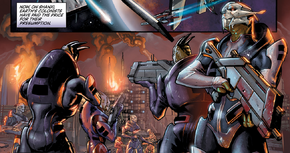
Over the side by side several weeks, the outnumbered Brotherhood lost multiple scouting parties and patrols to turian offensives. The conflict came to a head when a turian fleet bankrupt through Alliance lines and besieged the human being colony of Shanxi. With no other options, the Alliance garrison on Shanxi surrendered, and the turians proceeded to occupy the world, confident that the majority of Brotherhood forces had been defeated. However, one month later the Alliance's Second Fleet caught the turian occupiers by surprise and evicted them from the planet. Both sides began preparations for a protracted interplanetary war.
Before that could happen, the Citadel Council intervened and revealed the galactic community to humanity. Terms of peace were negotiated and the conflict finer brought to an end. The turians were ordered by the Quango to give heavy reparations to the Alliance for their part in instigating the conflict, known to the galaxy as the "Relay 314 Incident". Mistrust between both races would linger for years to come.
The Reaper State of war
During the Reaper invasion in 2186, the turian colony of Taetrus is one of the first worlds the Reapers attack following their conquest of Khar'shan and World. The Turian Hierarchy made two attempts to liberate Taetrus, but were unsuccessful. As the Reapers began to cascade into the Trebia system and assault Palaven, they broadcasted images of Taetrus's destruction to the turian comm buoy network.
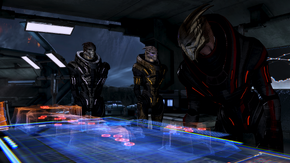
The Reapers met with heavy resistance from the turians during their invasion of Palaven and Menae; much of the turian armada remained operable subsequently the Reapers' initial assault, and the turian denizens was heavily armed and capable of supporting turian troops. Although the Hierarchy maintained that Palaven had not fallen and the battle for it continued, the Reapers however made significant gains and turian casualties quickly mounted.
Relief came with the help of an unlikely ally: the krogan, who had agreed to join the war in one case the genophage was cured. The combined turian and krogan counterattack caught the Reapers off-guard. While the Reaper armada orbiting Palaven was distracted by an apparent turian offensive, transport craft conveying krogan reinforcements landed on Palaven and coordinated with turian resistance forces, handing over warp bombs and fission weapons. These weapons were smuggled aboard Reaper ships and detonated simultaneously across the earth, allowing big swathes of territory to be retaken. News of the victory gave a much-needed boost to the morale of the turian resistance and the galactic public, but it was not long earlier the Reapers retaliated.
Realizing the hopelessness of the situation, Primarch Victus ordered the remaining turian warships to withdraw from the Trebia system in lodge to participate in the Allied assault on Earth. The only way to stop the state of war was to activate the Crucible, and doing so required the Citadel, which the Reapers had moved to Earth orbit for safekeeping. Turian forces heroically assisted in the space and ground battles, while Commander Shepard reached the Citadel to trigger the Crucible.
Culture
Since the Unification War, turians normally vesture elaborate tattoos[3] marking their colony of origin, though information technology is not known which markings distinguish which colony or if colour has any pregnant. These markings are usually white — particularly on turians with darker carapaces — but can be of other colors such as bluish for Garrus Vakarian or blood-red for Nyreen Kandros. The lack of facial markings is looked down upon in turian lodge; the turian term "barefaced" refers to 1 who is beguiling or not to be trusted. It is too a slang term for politicians.
Peel tones similar to Mordin Solus' ain are apparently attractive by turian standards. For male person turians at to the lowest degree, complimenting a potential partner'southward waist or head fringe seems to be a way of expressing attraction. Male grooming practices for attracting potential mates, for instance if going out on dates, include filing their talons and buffing their fringes.
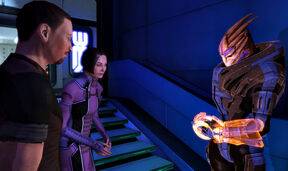
Turians are noted for their potent sense of public service. It is rare to find one who puts his needs alee of the grouping. Every denizen from age 15 to 30 serves the country in some capacity, as anything from a soldier to an ambassador, from a construction engineer to a sanitation worker. Turians have a stiff inclination toward public service and self-sacrifice, so they tend to be poor entrepreneurs. To compensate, they accepted the mercantile volus every bit a client race, offering protection in exchange for their fiscal expertise.
Turian society is highly regimented and very organized, and the species is known for its strict discipline and work ethic. Turians are willing to do what needs to be done, and they ever follow through. They are not hands spurred to violence, but when conflict is inevitable, they simply understand a concept of "full state of war." They exercise not believe in skirmishes or modest battles; they use massive fleets and numbers to defeat an antagonist so completely that they remove whatever threat of having to fight the aforementioned opponent more than once. They practise non exterminate their enemy, just so completely devastate their military machine that the enemy has no choice but to go a colony of the turians. It is theorized that another conflict between the chop-chop advancing humans and the turians could annihilate a large portion of known space.
The turian military is the centre of their order. It is not only an armed force; it is an extensive public works organization. The military machine law are also the civic police. The burn down brigades serve the noncombatant population as well as military machine facilities. The corps of engineers builds and maintains spaceports, schools, water purification plants, and power stations. The merchant marine ensures that all worlds become needed resources.
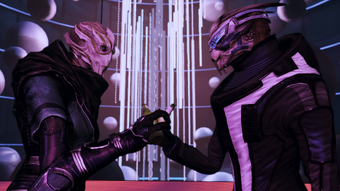
Other species see turians equally "men of activeness," and they are generally regarded as the most progressive of the Citadel races (though some species believe humans are rivalling this position). Since their civilization is based on the structure of a armed forces hierarchy, changes and advances accepted by the leadership are chop-chop adopted by the residue of guild with minimal resistance.
While turians are individuals with personal desires, their instinct is to equate the self with the grouping, and to set aside all personal desires for the good of all. Turians are taught to have a strong sense of personal accountability, the 'turian laurels' that other races observe so remarkable. Turians are taught to own every decision they make, good or ill. The worst sin they tin can brand in the eyes of their people is to prevarication nigh their ain deportment. Turians who murder will try to go away with it, just if directly questioned, most will confess the crime. Nepotism, while nowadays, is rare and looked down upon by the turians, almost of whom instead espouse and practice meritocracy in regards to the handing of positions of power.
Economy
The turian economy is vastly larger than that of the Brotherhood, but cannot match the size and power of that of the asari. For many years, development was hampered past cultural disinterest in economics. When the turians accepted the volus as a customer race, business organization development improved.
The military is supported by a well-developed infrastructure. Manufacturers such equally Armax Armory and the Haliat Armory produce advanced, reliable equipment. Volus manufacturers accept been known to produce cheap knock-offs of turian equipment.
Religion
Turians believe that groups and areas have "spirits" that transcend the individual. For example, a armed services unit would be considered to take a literal spirit that embodies the honour and courage information technology has displayed. A city's spirit reflects the accomplishments and industry of its residents. An ancient tree's spirit reflects the beauty and tranquility of the area it grows inside.
These spirits are neither practiced nor evil, nor are they appealed to for intercession. Turians do not believe spirits can affect the world, merely spirits tin can inspire the living. Prayers and rituals allow an private to antipodal with a spirit for guidance or inspiration. For example, a turian who finds his loyalty tested may appeal to the spirit of his unit, hoping to reconnect with the pride and honor of the group. A turian who wishes to create a work of fine art may effort to connect with the spirit of a cute location.
Turians enjoy absolute freedom of religion and can exercise whatever appeals to them so long as it does not impede anyone'south ability to perform their duties. There are many practitioners of the asari siarist philosophy. Since opening dialog with the human Systems Alliance, some turians take embraced Confucianism and Zen Buddhism.
In the by, turians believed that titans strode across Palaven, reaching for the heavens. They worshiped these deities and communicated with them at a structure called Temple Palaven. The temple was tended to by a religious order called the Valluvian Priests, who article of clothing special purple robes which obscure their forms. In order for turians to join this guild, they had to exist considered worthy enough through some activeness. When the turians spread out from Palaven and discovered other life among the stars, however, they sealed Temple Palaven because they no longer needed legends to prod them upward. With the temple abased, eventually the Valluvian Priests roughshod into legend.
Government
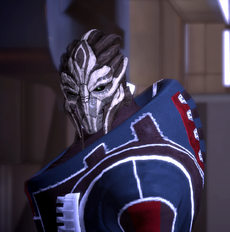
The turian government, known as the Turian Hierarchy, is a hierarchical meritocracy. While it has great potential for misuse, this is tempered by the civic duty and personal responsibility turians learn during their babyhood.
Turians take 27 citizenship tiers, get-go with civilians (customer races and children). The initial menstruation of military service is the second tier. Formal citizenship is conferred at the third tier, after kick camp. For client races, citizenship is granted later on the individual musters out. Higher-ranked citizens are expected to pb and protect subordinates. Lower-ranking citizens are expected to obey and back up superiors. Promotion to another tier of citizenship is based on the personal assessment of ane's superiors and co-rankers. At the superlative are the Primarchs, who each rule a colonization cluster. The Primarchs vote on matters of national importance. They otherwise maintain a "hands-off" policy, trusting the citizens on each level below them to do their jobs competently.
Throughout their lives, turians arise to the higher tiers and are occasionally "demoted" to lower ones. The stigma associated with demotion lies non on the individual, but on those who promoted them when they weren't fix for additional responsibility. This curbs the tendency to promote individuals into positions beyond their capabilities. Settling into a role and rank is not considered stagnation. Turians value knowing 1'southward ain limitations more than being ambitious.
Turians enjoy wide freedoms. So long as one completes their duties, and does not prevent others from completing theirs, nothing is forbidden. For example, in that location are no laws against recreational drug apply, but if someone is unable to complete their duties due to drug use, their superiors stride in. Judicial proceedings are 'interventions.' Peers limited their concern, and endeavor to convince the offender to change. If rehabilitation fails, turians accept no qualms near sentencing dangerous individuals to life at hard labor for the state.
The turian purple anthem is chosen "Die for the Cause."
Military
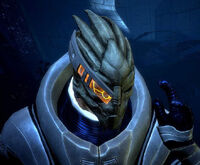
Although they lack the brutality of the krogan, the refined biotic skill of the asari, and the adaptability of the humans, the turian military has formidable discipline. Officers and NCOs are "lifers" with years of field feel. Enlisted personnel are thoroughly trained and stay calm under fire. Turian units don't break. Even if their entire line collapses, they fall back in order, setting ambushes as they go. A pop maxim holds: "You will only meet a turian'southward dorsum one time he'due south expressionless."
Kick military camp begins on the 15th birthday. Soldiers receive a twelvemonth of training before being assigned to a field unit; officers railroad train for even longer. Well-nigh serve until the historic period of 30, at which they get role of the Reserves. Even if they suffer injuries preventing forepart-line service, most do support work behind the lines.
Biotics are uncommon. While admired for their exacting skills, biotics' motives are not e'er fully trusted by the common soldier. The turians prefer to assign their biotics to specialist teams called Cabals.
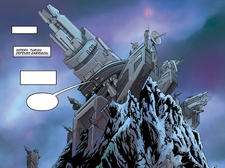
Command and control is decentralized and flexible. Private squads can telephone call for arms and air support. They make extensive utilise of combat drones for low-cal duties and Six-controlled fighters, and exercise combined arms: infantry operates with armor, supported by overhead gunships. Strategically, they are methodical and patient, and dislike risky operations.
Tradition is of import. Each legion has a full-fourth dimension staff of historians who chronicle its battle honors in detail. The oldest have records dating back to the turian Iron Age. If a legion is destroyed in battle, information technology is reconstituted rather than being replaced.
The turians recruit auxiliary units from conquered or absorbed minor races, like the volus. Auxiliaries are generally light infantry or armored cavalry units that screen and support the primary battle formations. At the conclusion of their service in the Auxiliaries, recruits are granted turian citizenship.
Turian wars are oftentimes marked by citizen resistance. About turian families keep small arms in their homes and take basic training courses that include instruction on how to create simple anti-vehicle explosive devices. To suppress citizen militias, the Turian Hierarchy makes utilise of "execution squads" known as hastatim. First, "safe camps" are established in cities to incentivize give up. Next, hastatim soldiers are deployed door-to-door; anyone who refuses to be transported to a safe military camp or demonstrates hostile intent will be shot. Hastatim burial units then retrieve and cremate the bodies. This arroyo is necessary because without the rubber camps, no turian would always give up, and without the hastatim, it would accept years for a population to be pacified.
The mainstay of the turian infantry is the Phaeston assault rifle, a lite, accurate, and versatile weapon that however packs more punch than other rifles of its size. Other turian weapons include the Krysae anti-materiel sniper burglarize, and the ML-77 Missile Launcher, manufactured by Armax Armory, one of the turian military'southward primary suppliers. Vehicles the turians employ include the A-61 Mantis Gunship, a versatile multi-role aircraft, the C77 Tyrus, a durable 13-ton infantry fighting vehicle, an APC variant of the Thousand-080, the Jiris Infantry Fighting Vehicle, a hovercraft capable of traversing about terrains and engaging enemies at 20 kilometers with its missiles.
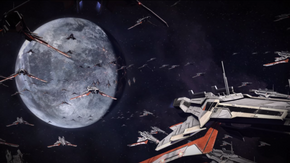
The turian navy is divided into at least 32 fleets, and is allotted more than dreadnoughts by the Treaty of Farixen than any other race; the turians possessed 37 dreadnoughts in 2183 CE and 39 every bit of 2185 CE, and in 2186 CE the Turian Bureaucracy and the Vol Protectorate were jointly gifted the dreadnought Kwunu past the Elkoss Combine. The turians are as well known to possess at least two fighter carriers. The navy serves as a galactic peacekeeping force, and is also the primary military arm of the Council, contributing the single largest portion of the Citadel Fleet.
Notable units of the turian military include the 26th Armiger Legion, 79th Flotilla, 6th Fleet, 43rd Marine Division, Seventh Armada, and Blackwatch.
Known Armed forces Actions
- Unification Wars (500 BCE)
- Krogan Rebellions (700-800 CE)
- Battle of Canrum
- Battle of Digeris
- Battle of Gellix
- Boxing of Uresium
- Relay 314 Incident (2157 CE)
- Battle of the Citadel (2183 CE)
- State of war on Taetrus (2185 CE)
- Raids on Cerberus Bases (2186 CE)
- The Reaper War (2186 CE)
- Fall of Taetrus
- Battle of Palaven
- Battle of Tuchanka
- Relief of the ninth Platoon
- 9th Platoon Bomb Recovery Mission
- The Miracle at Palaven
- Boxing of Earth
Notable Turians
Turian Worlds
Trivia
- Turian is based on the word centurion. Palaven is based on Palatine Hill, likewise as the give-and-take "paladin." Turian names, culture, and military doctrine besides mirror that of the Roman Empire, especially their accent on colonizing enemies.
- The turian culture of public service was inspired by the Terran Federation, the homo lodge described in Robert Heinlein's novel Starship Troopers.
- Female person turians did not take game models until the release of the Mass Effect 3: Omega DLC, five years after the first game. This, at least in the original Mass Upshot, was because at that place was insufficient evolution time and retention budget to back up ii different versions of the same species. Another reason, according to Art Director Derek Watts, was the simple question of how to differentiate their faces from the males.[4] Abrudas, from the comic Mass Effect: Evolution, is the outset female turian to exist visually depicted in the series.
- According to The Art of Mass Effect, turian ships incorporated layers of plates to roughly symbolize the feathered appearance of the turians themselves.
- Turians are a playable race in Mass Outcome 3's cooperative multiplayer style.
- In Mass Result 3, on the mission Tuchanka: Bomb, a turian shot past a sniper is shown as having carmine blood. In all other instances, turian claret is portrayed equally blue.
See As well
- Turians at the Mass Effect: Conflicting Race Profiles
References
- ↑ http://twitter.com/#!/patsquinade/status/92455499546632193
- ↑ http://meforums.bioware.com/viewtopic.html?topic=599022&forum=123
- ↑ http://www.gameinformer.com/b/features/archive/2011/04/22/mass-upshot-3-creating-garrus.aspx
- ↑ http://www.gameinformer.com/b/features/archive/2011/04/22/mass-event-3-creating-garrus.aspx
| | Races | | ||
|---|---|---|---|---|
| Citadel | Asari • Drell • Elcor • Hanar • Human • Keeper • Salarian • Turian • Volus | |||
| Non-Citadel | Batarian • Collector • Geth • Krogan • Leviathan • Quarian • Raloi • Reaper Virtual Conflicting • Vorcha • Yahg | |||
| Historical | Prothean • Rachni • Other Historical Races | |||
| Andromeda | Angara • Jardaan • Kett • Remnant | |||
Source: https://masseffect.fandom.com/wiki/Turian
0 Response to "Dual Monitor Wallpaper Modern Art Mass Effect Art Alliance Fleet Tokyo"
Post a Comment